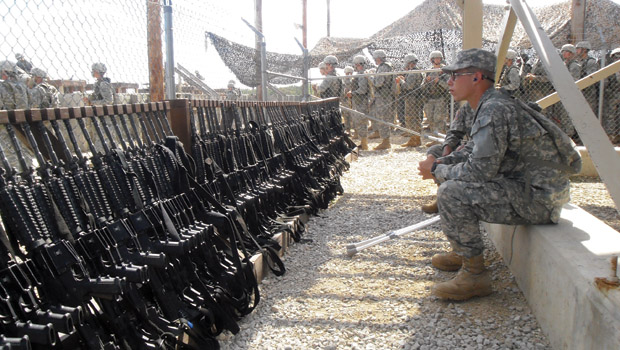Without a doubt, the comprehensive agenda of briefings, one-on-one interviews, and weapons demonstrations offered delegates — including reporters from Time, Al-Ahram, and Arab News — a comprehensive understanding of how the US Army recruits, trains and prepares soldiers for military operations in Iraq and Afghanistan.
The program also revealed how American commanders have learned from some of their best-known mistakes: the scandalous mistreatment of detainees at Abu Ghraib military prison and the virtually effortless capture of several uniformed personnel — including Army Private Jessica Lynch — at the beginning of Operation Iraqi Freedom in 2003.
Lieutenant General Robert L. Caslen, Commanding General, US Army Combined Arms Center, the “CAC,” at Fort Leavenworth, Kansas, said the Army is keen to use lessons learned from the field to enhance how Army Soldiers are trained and to expand the educational experience of mid-career military officers graduating from the CAC.
“When we learn a lesson overseas — or anywhere — we push it out to Soldiers as quickly as possible,” said Caslen.
The press tour, called “Bridging the Gap,” was jointly sponsored by the CAC’s Command and General Staff College (sometimes known as the “Intellectual Center of the Army”) and the William Allen White School of Journalism at the University of Kansas. Costs were underwritten by the McCormick Foundation, a nonprofit organization created by one of the founders of the Chicago Tribune.
“‘Bridging the Gap’ enables our two cultures — the military and the media — to better know each other,” said Dr. Tom Volek, the Kansas University professor who led the group and organized the program. “We want journalists to come away from the week-long experience liking the Army, while also having the Army feel the same way about journalists.”
During briefings at Fort Leavenworth — a sprawling, tree-shaded Army post on the banks of the Missouri River — reporters were briefed on subjects ranging from recruiting (“Many Army enlistees are coming in with undergraduate and multiple Masters degrees – probably because of the tough job market”) to the significance of military insignia (“A Major outranks a Lieutenant, but a Major is outranked by a Lieutenant-General”). They were also informed by one briefer, Dr. W. Chris King, Dean of Academics at the CAC’s Command and General Staff College, how “cultural competency” and “operational culture awareness” have lately been embraced by Army leaders.
“We want our commanders to be cultural analysts; we want them to look at any situation that they may encounter overseas, and see what is needed,” King said. “We have failed at that in the past. And yet we now realize that (operational culture awareness) is the key to counterinsurgency operations.”
At neighboring Fort Leonard Wood, Missouri, the group was offered an up-close experience of how basic training for Army recruits now emphasizes “real world” combat situations. The reporters used night vision devices to watch 20 “turtle crawling” Privates — each weighted down with a rifle and 55 pounds of gear — as they struggled over, under, and through barbed-wire obstructions stretched across100 yards of pitch-black terrain. The chaos of the nighttime training exercise was compounded by several burning vehicles, the ear-shattering boom of mortar simulators, criss-crossing streams of machinegun tracer bullets whizzing (safely) overhead and the wavering light cast from an occasional illumination flare.
The reporters didn’t just observe recruit training, they also experienced it: awakening at 4:00 a.m. for physical exercise, lunching on meals-ready-eat (MREs), visiting a live-fire machinegun range and testing their marksmanship skills on ultra-realistic firearms simulators for weapons ranging from the .50 caliber machinegun to the Mk-19 40-mm grenade launcher.
“It’s better and cheaper for recruits to gain weapons proficiency on the simulators before they start using live ammunition,” said Rick McMullen, a weapons instructor, who added that its costs nearly $48 for every 40-mm grenade used out on the firing range.
Returning to Fort Leavenworth, this Arab News reporter met with several instructors from the CAC’s Middle East Studies Department to learn about the Army’s effort to educate military commanders about how to be more culturally aware.
“Our students are largely Army Majors in the 12th year of their career. Most will advance to full Colonel, many will become General officers,” said John Cary, one of the CAC professors. “We don’t teach them what to think, we teach them how to think.” Another CAC professor, Eric McMillin, said his students receive a minimum of four hours of instruction in “Culture in Military Operations.”
“We fight wars in a variety of environments — the desert, jungle, mountains and arctic. There is now recognition that knowing how to operate well in the human terrain is just as important as operating well on the geographic terrain,” said McMillin.
Gary Hobin, a former State Department Foreign Service Officer with extensive experience in the Middle East, said that operational culture courses taught at the CAC often provide military personnel the context to finally understand what they observed in recent overseas deployments.
“Frequently, my students will see the broader, proper context of something that they have experienced in Iraq or Afghanistan, and they will say — right in the middle of one of my sessions — ‘Oh. Now I understand.’”
This prompted John Cary to quickly add: “That realization by a commander, that understanding of why people did the things that the commander witnessed overseas — but did not understand — usually has something to do with culture.”










